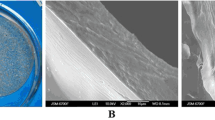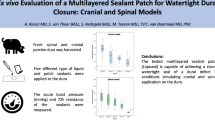Abstract
Duraplasty is necessary in nearly 30% of all neurological surgeries. Different tissues and materials have been evaluated in dura mater repair or as dural substitutes in neurosurgery. The aim was to evaluate the biocompatibility of the bacterial cellulose (BC) membranes, produced from sugarcane molasses, for dural defect repair in rats. Forty adults males Wistar rats divided into two groups: a control (ePTFE) and an experimental (BC). Bilateral frontoparietal craniectomy was performed, and a dural defect was created. The arachnoid underlying defect was disrupted with a narrow hook. The animals were observed for 120 days. There were no cases of infection, cerebrospinal fluid fistulae, delayed hemorrhages, behavior disturbances, seizures and palsies. The BC membrane showed to have suitable biocompatibility properties, was not induced immune reaction, nor chronic inflammatory response and absence of neurotoxicity signals.
Graphical Abstract



Similar content being viewed by others
References
Becker SS, Jackler RK, Pitts LH. Cerebrospinal fluid leak after acoustic neuroma surgery: a comparison of the translabyrinthine, middle fossa, and retrosigmoid approaches. Otol Neurotol. 2003;24:107–12.
Kuhn J, Hofmann B, Knitelius H, Coenen H, Bewermeyer H. Bilateral subdural haematoma and lumbar pseudomeningocele due to a chronic leakage of liquor cerebrospinalis after a lumbar discectomy with the application of ADCON-L gel. J Neurol Neurosurg Psychiatry. 2005;76:1031–33.
Sabatino G, Della Pepa GM, Bianchi F, Capone G, Rigante L, Albanese A, Maira G, Marchese E. Autologous dural substitutes: a prospective study. Clin Neurol Neurosurg. 2014;116:20–23.
Ostendorf AP, Connolly AM. Medical management of eosinophilic meningitis following bovine graft duraplasty for Chiari malformation type I repair. J Neurosurg Pediatr. 2013;12:357–9.
Sandoval-Sanchez JH, Ramos-Zuniga R, de Anda SL, Lopez-Dellamary F, Gonzalez-Castaneda R, Ramírez-Jaimes de L, Jorge-Espinoza G. A new bilayer chitosan scaffolding as a dural substitute: experimental evaluation. World Neurosurg. 2012;77:577–82.
Lam FC, Kasper E. Augmented autologous pericranium duraplasty in 100 posterior fossa surgeries-a retrospective case series. Neurosurgery. 2012;71(2 Suppl Operative):ons302–7. doi:10.1227/NEU.0b013e31826a8ab0.
Gazzeri R, Galarza M, Alfieri A, Neroni M, Roperto R. Simple intraoperative technique for minor dural gap repair using fibrin glue and oxidized cellulose. World Neurosurg. 2011;76:173–5.
Messing-Jünger AM, Ibanez J, Calbucci F, Choux M, Lena G, Mohsenipour I, Van Calenbergh F. Effectiveness and handling characteristics of a three-layer polymer dura substitute: a prospective multicenter clinical study. J Neurosurg. 2006;105:853–8.
Yamada K, Miyamoto S, Nagata I, Kikuchi H, Ikada Y, Iwata H, Yamamoto K. Development of a dural substitute from synthetic bioabsorbable polymers. J Neurosurg. 1997;86:1012–7.
Malliti M, Page P, Gury C, Chomette E, Nataf F, Roux FX. Comparison of deep wound infection rates using a synthetic dural substitute (Neuropatch) or pericranium graft for dural closure: a clinical review of 1 year. Neurosurgery. 2004;54:599–604.
Knopp U, Christmann F, Reusche E, Sepehrnia A. A new collagen biomatrix of equine origin versus a cadaveric dura graft for the repair of dural defects - a comparative animal experimental study. Acta Neurochir (Wien). 2005;147:877–87.
Clausen F, Lindh T, Salimi S, Erlandsson A. Combination of growth factor treatment and scaffold deposition following experimental traumatic brain injury show a temporary effect on cellular regeneration. Brain Res. 2014;1588:37–46.
Khan F, Ahmad SR. Polysaccharides and Their derivatives for versatile tissue engineering application. Macromol Biosci. 2013;13:395–421.
Mello LR, Feltrin LT, Fontes Neto PT, Ferraz FA. Duraplasty with biosynthetic cellulose: an experimental study. J Neurosurg. 1997;86:143–50.
Mello LR, Alcantara BB, Bernardes CI, Boer VH. Late favorable results of duraplasty with biocellulose: clinical retrospective study of 20 cases. Arq Bras Neurocir. 2012;31:128–34. http://files.bvs.br/upload/S/0103-5355/2012/v31n3/a3396.pdf.
Rosen CL, Steinberg GK, Demonte F, Delashaw JB, Lewis SB, Shaffrey ME, Aziz K, Hantel J, Marciano FF. Results of the prospective, randomized, multicenter clinical trial evaluating a biosynthesized cellulose graft for repair of dural defects. Neurosurgery. 2011;69:1093–103.
Xu C, Ma X, Chen S, Tao M, Yuan L, Jing Y. Bacterial Cellulose Membranes Used as Artificial Substitutes for Dural Defection in Rabbits. Int J Mol Sci. 2014;15:10855–67.
Kowalska-Ludwicka K, Cala J, Grobelski B, Sygut D, Jesionek-Kupnicka D, Kolodziejczyk M, Bielecki S, Pasieka Z. Modified bacterial cellulose tubes for regeneration of damaged peripheral nerves. Arch Med Sci. 2011;9(3):527–34. doi:10.5114/aoms.2013.33433. 20.
Pértile RAN, Moreira S, Andrade FK, Domingues L, Gama M. Bacterial cellulose modified using recombinant proteins to improve neuronal and mesenchymal cell adhesion. Biotechnol Prog. 2012;28:526–32.
Paterson-Beedle M, Kennedy JF, Melo FAD, Lloyd LL, Medeiros V. Cellulosic exopolysaccharide produced from sugarcane molasses by a Zoogloea sp. Carbohydr Polym. 2000;42:375–83.
Cavalcante AHM, Carvalho LB, Carneiro-da-Cunha MG. Cellulosic exopolysaccharide produced by Zoogloea sp. as a film support for trypsin immobilization. Biochem Eng J. 2006;29:258–61.
Carvalho Junior AM, Santos MM, Barkokébas BB, de Andrade Aguiar JL, Lima SVC, Dambros M. Characterization of the deposition of collagen fibers and lithogenic potential in bladder of rats submitted to a sugar cane biopolymer graft. Int Braz J Urol. 2012;38:544–51.
Albuquerque PCVC, Aguiar JLA, Santos SM, Pontes Filho N, Mello RJV, Costa MLCR. Comparative study of the areas of osteochondral defects produced in the femoral condyles of rabbits treated with gel of sugarcane biopolymer. Acta Cir Bras. 2011;26:383–6.
Medeiros Junior MD, Carvalho EJDA, Catunda IS, Bernardino-Araujo S, Aguiar JLA. Hydrogel of polysaccharide of sugarcane molasses as carrier of bone morphogenetic protein in the reconstruction of critical bone defects in rats. Acta Cir Bras. 2013;28:233–8.
Aguiar JLA, Lins EM, Barros Marques SR, Barros Coelho AR, Rossiter RO, Melo RJV. Surgarcane biopolymer patch in femoral artery angioplasty on dogs. Acta Cir Bras. 2007;22:77–81.
De Barros-Marques SR, Marques-Lins E, De Albuquerque MCS, Aguiar JLA. Sugarcane biopolymer patch in femoral vein angioplasty on dogs. J Vasc Surg. 2012;55:517–21.
Falcão SC, Coelho ARDB, Evêncio Neto J. Biomechanical evaluation of microbial cellulose (Zoogloea sp.) and expanded polytetrafluoroethylene membranes as implants in repair of produced abdominal wall defects in rats. Acta Cir Bras. 2008;23:184–91.
Silveira RK, Coelho AR, Pinto FC, de Albuquerque AV, de Melo Filho DA, de Andrade Aguiar JL. Bioprosthetic mesh of bacterial cellulose for treatment of abdominal muscle aponeurotic defect in rat model. J Mater Sci Mater Med. 2016;27(8):129. doi:10.1007/s10856-016-5744-z.
Fragoso AS, Silva MB, De Melo CP, Aguiar JLA, Rodrigues CG. Dielectric study of the adhesion of mesenchymal stem cells from human umbilical cord on a sugarcane biopolymer. J Mater Sci Mater Med. 2014;25:229–37.
Castro CMMB, Aguiar JLA, Melo FAD, Silva WTF, Marques E, Silva DB. Sugarcane biopolymer cytotoxicity. An Fac Med Univ Fed Pernamb. 2004;49:119–23. http://www.anaisdemedicina.revistaonline.org/_Secao/3289/_Pagina/Revista/ArtigoVisualizar.aspx?artigoId=85&ass=64816093.
Pinto FCM, De-Oliveira ACAX, De-Carvalho RR, Gomes-Carneiro MR, Coelho DR, Lima SVC, Paumgartten FJR, Aguiar JLA. Acute toxicity, cytotoxicity, genotoxicity and antigenotoxic effects of a cellulosic exopolysaccharide obtained from sugarcane molasses. Carbohydr Polym. 2016;137:556–60.
Lucena MT, Melo Júnior MR, Lira MMM, Castro CM, Cavalcanti LA, Menezes MA, Pinto FCM, Aguiar JLA. Biocompatibility and cutaneous reactivity of cellulosic polysaccharide film in induced skin wounds in rats. J Mater Sci Mater Med. 2015;26:5410
Gortler M, Braun M, Becker I, Roggendorf W, Heiss E, Grote E. Animal experiments with a new dura graft (polytetraflurethylene). Results. Neurochirurgia (Stuttg). 1991;34:103–6.
Yamagata S, Goto K, Oda Y, Kikuchi H. Clinical experience with expanded polytetrafluoroethylene sheet used as an artificial dura mater. Neurol Med Chir (Tokyo). 1993;33:582–5.
Matsumoto Y, Aikawa H, Tsutsumi M, Narita S, Yoshida H, Etou H. Histological examination of expanded polytetrafluoroethylene artificial dura mater at 14 years after craniotomy. Neurol Med Chir (Tokyo). 2013;53:43–6.
Viñas FC, Ferris D, Kupsky WJ, Dujovny M. Evaluation of expanded polytetrafluoroethylene (ePTFE) versus polydioxanone (PDS) for the repair of dura mater defects. Neurol Res. 1999;21:262–8.
Walcott BP, Neal JB, Sheth SA, Kahle KT, Eskandar EN, Coumans JV. The incidence of complications in elective cranial neurosurgery associated with dural closure material. J Neurosurg. 2014;120:278–84.
Vakis A, Koutentakis D, Karabetsos D, Kalostos G. Use of polytetrafluoroethylene dural substitute as adhesion preventive material during craniectomies. Clin Neurol Neurosurg. 2006;108:798–802.
Nazzaro JM, Craven DE. Successful treatment of postoperative meningitis due to Haemophilus influenzae without removal of an expanded polytetrafluoroethylene dural graft. Clin Infect Dis. 1998;26:516–8.
Nakagawa S, Hayashi T, Anegawa S, Nakashima S, Shimokawa S, Furukawa Y. Postoperative infection after duraplasty with expanded polytetrafluoroethylene sheet. Neurol Med Chir (Tokyo). 2003;43:120–4.
Sandoval-Sánchez JH, Ramos-Zúñiga R, Luquín De Anda S, López-Dellamary F, Gonzalez-Castañeda R, Ramírez-Jaimes JDLC. A new bilayer chitosan scaffolding as a dural substitute: Experimental evaluation. World Neurosurg. 2012;77:577–82.
Acknowledgements
Research Performed at Center for Experimental Surgery of the Federal University of Pernambuco UFPE, Recife-PE, Brazil. Research Performed at collaboration with the Laboratory of Human Reproduction of the University of São Paulo (UNIFESP), Laboratory of Immunopathology Keizo Asami (LIKA), and the Department of Nuclear Energy (DEN) of the Federal University of Pernambuco, Recife/PE, Brazil. The English version of this text has been revised by a native speaker, Sidney Pratt, Canadian, BA, MAT (The Johns Hopkins University), RSA diploma (TEFL) University of Cambridge.
Funding
National Council for Scientific and Technological Development (CNPq).
Author information
Authors and Affiliations
Corresponding author
Ethics declarations
Conflict of interest
The authors declare that they have no competing interests.
Rights and permissions
About this article
Cite this article
Lima, F.d.M.T., Pinto, F.C.M., Andrade-da-Costa, B.L.d.S. et al. Biocompatible bacterial cellulose membrane in dural defect repair of rat. J Mater Sci: Mater Med 28, 37 (2017). https://doi.org/10.1007/s10856-016-5828-9
Received:
Accepted:
Published:
DOI: https://doi.org/10.1007/s10856-016-5828-9




